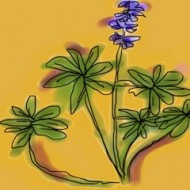The Dry Garden: Streetwise
It was spotting a pumpkin identified as a gourd that prompted Leigh Adams to write John Lyons. She was (and is) an expert in gourd-craft as well as the artist-in-residence at the Los Angeles County Arboretum and Botanic Garden. Lyons, whose website carried the photo of the pumpkin, was (and is) a garden designer and regular lecturer at the Arboretum. Yet until Adams wrote, they had never met. That was two years ago. They now joke that they are “as much in love as a non-couple could be.” And they have a baby, a four-month-old garden that is brimming with art, native sages, fruit trees and irrigated by rainwater harvested from the street.
Click here to keep reading “The Dry Garden” in the Los Angeles Times.
…
The Dry Garden: Fremont’s flower
Some years ago, the website of Native Sons Nursery had a photograph of a California flannel bush that had been trained to grow along a garden wall. Each bloom in a spangle of flowers was the size of a tea cup. Their yellow could outshine a daffodil, or sunflower. This wasn’t a garden, it was a garden that Matisse dreamed. On seeing that photo, so began years of looking in Los Angeles area gardens for espaliered examples of the glorious genus of natives whose botanical name is Fremontodendron.
And never finding one.
It turns out that the photograph was taken in Guernsey by Native Sons co-founder David Fross, who had just left a place that serves alcohol when he saw the glorious display by one of the signature plants of California chaparral growing in one of the Channel Islands between Britain and France. “I’d had two martinis and half …
The Dry Garden: Speak now or forever hold your peace
Sprinkler run-off streams down Baldwin Avenue from Los Angeles County Arboretum street plantings past the county's public works office until it is plated into a sewer system that takes it to the Pacific Ocean. This is water from a reserve that is largely imported from the Colorado River and San Francisco Bay tributaries, pumped to Southern California at huge cost to the environment, treated to potability at great expense to us, then sprayed on inappropriate hedges with inappropriate irrigation equipment so that it is quickly turned into a ribbon of polluted urban slobber. And it is the County of Los Angeles doing it in a place where residents are supposed to learn the best garden practices.
Since arriving at the Los Angeles County Arboretum & Botanic Garden more than a year and a half ago, Chief Executive Richard Schulhof has been listening.
The region’s leading horticultural figures have been invited …
Meet ‘Dekopon’
“I still remember the first time I tasted the legendary fruit the Dekopon. Think of a huge mandarin, easy to peel and seedless, with firm flesh that melts in the mouth, an intense sweetness balanced by refreshing acidity, and a complex, lingering mandarin orange aroma. I’ve tasted more than 1,000 varieties of citrus, and to me the Dekopon is the most delicious,” writes UC Riverside pomologist David Karp in today’s Los Angeles Times.
I have no way of knowing what else Karp has tasted in his many years traveling the country visiting orchards and writing about fruit for his weekly column in the Los Angeles Times and former columns in the New York Times and Gourmet, but I do know that the Dekopon is extraordinary, like a perfect sorbet, except made by a tree instead of a chef. David, pictured above holding a Dekopon, happened to be visiting a …
The Dry Garden: Best dressed list
If the view from your front window is a hedge so maimed by years of buzzing that the only option is to buzz it some more, and if you have better things to do with your money than pay yard crews to torture shrubbery, it may be time to dig out that green wall and start over.
But before sharpening the pickax, dream. Dream aloud. There is no better time than February to view California’s native lilac, lemonade berry, coffeeberry, gooseberry and barberry plants, most of which are in full flower at Rancho Santa Ana Botanic Garden.
A tour of Southern California’s best native garden in midwinter reveals these shrubs dripping with gold, white, pink and blue flowers. Although the blossoms are admittedly fleeting accessories, they are succeeded by berries.
Apologies for language that sounds like red carpet commentary. It’s unfair to the plants. Click here to keep reading …
« go back — keep looking »

